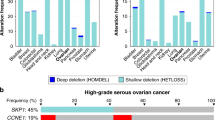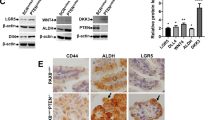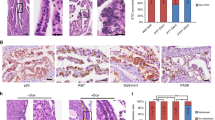Abstract
Liver kinase B1 (LKB1) is a tumor suppressor ubiquitously expressed serine/threonine protein kinase involved in energy metabolism and cellular polarity. In microarray experiments that compared normal tubal epithelium with high-grade serous carcinoma (HGSC), we observed a decrease in LKB1 mRNA expression in HGSC. In this study, we demonstrate that loss of cytoplasmic and nuclear LKB1 protein expression is frequently observed in tubal cancer precursor lesions as well as in both sporadic and hereditary HGSCs compared with other ovarian cancer histotypes. Bi-allelic genomic loss of LKB1 in HGSC did not account for the majority of cases with a decrease in protein expression. In vitro, shLKB1-fallopian tube epithelial (FTE) cells underwent premature cellular arrest and in ex vivo FTE culture, LKB1 loss and p53 mutant synergized to disrupt apical to basal polarity and decrease the number of ciliated cells. Overexpression of cyclin E1 allowed for bypass of LKB1-induced cellular arrest, and increased both proliferation and anchorage-independent growth of transformed FTE cells. These data suggest that LKB1 loss early in ovarian serous tumorigenesis has an integral role in tumor promotion by disrupting apical to basal polarity in the presence of mutated p53 in fallopian tube cells.
This is a preview of subscription content, access via your institution
Access options
Subscribe to this journal
Receive 50 print issues and online access
$259.00 per year
only $5.18 per issue
Buy this article
- Purchase on Springer Link
- Instant access to full article PDF
Prices may be subject to local taxes which are calculated during checkout






Similar content being viewed by others
References
Siegel R, Naishadham D, Jemal A . Cancer statistics, 2013. Cancer J Clin 2013; 63: 11–30.
Tone AA, Begley H, Sharma M, Murphy J, Rosen B, Brown TJ et al. Gene expression profiles of luteal phase fallopian tube epithelium from BRCA mutation carriers resemble high-grade serous carcinoma. Clin Cancer Res 2008; 14: 4067–4078.
George SH, Greenaway J, Milea A, Clary V, Shaw S, Sharma M et al. Identification of abrogated pathways in fallopian tube epithelium from BRCA1 mutation carriers. J Pathol 2011; 225: 106–117.
Launonen V . Mutations in the human LKB1/STK11 gene. Hum Mutat 2005; 26: 291–297.
TCGA. Integrated genomic analyses of ovarian carcinoma. Nature 2011; 474: 609–615.
Matulonis UA, Hirsch M, Palescandolo E, Kim E, Liu J, van Hummelen P et al. High throughput interrogation of somatic mutations in high grade serous cancer of the ovary. PLoS One 2011; 6: e24433.
Shaw PA, Rouzbahman M, Pizer ES, Pintilie M, Begley H . Candidate serous cancer precursors in fallopian tube epithelium of BRCA1/2 mutation carriers. Mod Pathol 2009; 22: 1133–1138.
Lee Y, Miron A, Drapkin R, Nucci MR, Medeiros F, Saleemuddin A et al. A candidate precursor to serous carcinoma that originates in the distal fallopian tube. J Pathol 2007; 211: 26–35.
Jarboe E, Folkins A, Drapkin R, Ince T, Agoston E, Crum C . Tubal and ovarian pathways to pelvic epithelial cancer: a pathological perspective. Histopathology 2008; 53: 127–138.
Chen EY, Mehra K, Mehrad M, Ning G, Miron A, Mutter GL et al. Secretory cell outgrowth, PAX2 and serous carcinogenesis in the Fallopian tube. J Pathol 2010; 222: 110–116.
Karst AM, Jones PM, Vena N, Ligon AH, Liu JF, Hirsch MS et al. Cyclin e1 deregulation occurs early in secretory cell transformation to promote formation of fallopian tube-derived high-grade serous ovarian cancers. Cancer Res 2014; 74: 1141–1152.
Sehdev AS, Kurman RJ, Kuhn E, Shih IeM . Serous tubal intraepithelial carcinoma upregulates markers associated with high-grade serous carcinomas including Rsf-1 (HBXAP), cyclin E and fatty acid synthase. Mod Pathol 2010; 23: 844–855.
Visvanathan K, Vang R, Shaw P, Gross A, Soslow R, Parkash V et al. Diagnosis of serous tubal intraepithelial carcinoma based on morphologic and immunohistochemical features: a reproducibility study. Am J Surg Pathol 2011; 35: 1766–1775.
Vang R, Visvanathan K, Gross A, Maambo E, Gupta M, Kuhn E et al. Validation of an algorithm for the diagnosis of serous tubal intraepithelial carcinoma. Int J Gynecol Pathol 2012; 31: 243–253.
Milea A, George SH, Matevski D, Jiang H, Madunic M, Berman HK et al. Retinoblastoma pathway deregulatory mechanisms determine clinical outcome in high-grade serous ovarian carcinoma. Mod Pathol 2013; 27: 991–1001.
Hawley SA, Boudeau J, Reid JL, Mustard K.J, Udd L, Makela TP et al. Complexes between the LKB1 tumor suppressor, STRAD alpha/beta and MO25 alpha/beta are upstream kinases in the AMP-activated protein kinase cascade. J Biol 2003; 2: 28.
Hong SP, Leiper FC, Woods A, Carling D, Carlson M . Activation of yeast Snf1 and mammalian AMP-activated protein kinase by upstream kinases. Proc Natl Acad Sci USA 2003; 100: 8839–8843.
Woods A, Johnstone SR, Dickerson K, Leiper FC, Fryer LG, Neumann D et al. LKB1 is the upstream kinase in the AMP-activated protein kinase cascade. Curr Biol 2003; 13: 2004–2008.
Jeon SM, Chandel NS, Hay N . AMPK regulates NADPH homeostasis to promote tumour cell survival during energy stress. Nature 2012; 485: 661–665.
van Veelen W, Korsse SE, L van de Laar, Peppelenbosch MP . The long and winding road to rational treatment of cancer associated with LKB1/AMPK/TSC/mTORC1 signaling. Oncogene 2011; 30: 2289–2303.
ten Klooster JP, Jansen M, Yuan J, Oorschot V, Begthel H, Di Giacomo V et al. Mst4 and Ezrin induce brush borders downstream of the Lkb1/Strad/Mo25 polarization complex. Dev Cell 2009; 16: 551–562.
Contreras CM, Akbay EA, Gallardo TD, Haynie JM, Sharma S, Tagao O et al. Lkb1 inactivation is sufficient to drive endometrial cancers that are aggressive yet highly responsive to mTOR inhibitor monotherapy. Dis Model Mech 2010; 3: 181–193.
Carretero J, Shimamura T, Rikova K, Jackson AL, Wilkerson MD, Borgman CL et al. Integrative genomic and proteomic analyses identify targets for Lkb1-deficient metastatic lung tumors. Cancer Cell 2010; 17: 547–559.
McCarthy A, Lord CJ, Savage K, Grigoriadis A, Smith DP, Weigelt B et al. Conditional deletion of the Lkb1 gene in the mouse mammary gland induces tumour formation. J Pathol 2009; 219: 306–316.
Morton JP, Jamieson NB, Karim SA, Athineos D, Ridgway RA, Nixon C et al. LKB1 haploinsufficiency cooperates with Kras to promote pancreatic cancer through suppression of p21-dependent growth arrest. Gastroenterology 2010; 139: 586–597 597 e1-6.
Tanwar PS, Kaneko-Tarui T, Zhang L, Tanaka Y, Crum CP, Teixeira JM . Stromal liver kinase B1 [STK11] signaling loss induces oviductal adenomas and endometrial cancer by activating mammalian Target of Rapamycin Complex 1. PLoS Genet 2012; 8: e1002906.
Karuman P, Gozani O, Odze RD, Zhou XC, Zhu H, Shaw R et al. The Peutz-Jegher gene product LKB1 is a mediator of p53-dependent cell death. Mol Cell 2001; 7: 1307–1319.
May T, Virtanen C, Sharma M, Milea A, Begley H, Rosen B et al. Low malignant potential tumors with micropapillary features are molecularly similar to low-grade serous carcinoma of the ovary. Gynecol Oncol 2010; 117: 9–17.
George SH, Milea A, Shaw PA . Proliferation in the normal FTE is a hallmark of the follicular phase, not BRCA mutation status. Clin Cancer Res 2012; 18: 6199–6207.
Karst AM, Drapkin R . Primary culture and immortalization of human fallopian tube secretory epithelial cells. Nat Protoc 2012; 7: 1755–1764.
Levanon K, Ng V, Piao HY, Zhang Y, Chang MC, Roh MH et al. Primary ex vivo cultures of human fallopian tube epithelium as a model for serous ovarian carcinogenesis. Oncogene 2010; 29: 1103–1113.
Kuo KT, Guan B, Feng Y, Mao TL, Chen X, Jinawath N et al. Analysis of DNA copy number alterations in ovarian serous tumors identifies new molecular genetic changes in low-grade and high-grade carcinomas. Cancer Res 2009; 69: 4036–4042.
Levanon K, Ng V, Piao HY, Zhang Y, Chang MC, Roh MH et al. Primary ex vivo cultures of human fallopian tube epithelium as a model for serous ovarian carcinogenesis. Oncogene 2009; 29: 1103–1113.
Ning G, Bijron JG, Yuan J, Hirsch MS, McKeon FD, Nucci MR et al. Differential expression of p-ERM, a marker of cell polarity, in benign and neoplastic oviductal epithelium. Int J Gynecol Pathol 2013; 32: 345–352.
Kuhn E, Kurman RJ, Vang R, Sehdev AS, Han G, Soslow R et al. TP53 mutations in serous tubal intraepithelial carcinoma and concurrent pelvic high-grade serous carcinoma—evidence supporting the clonal relationship of the two lesions. J Pathol 2012; 226: 421–426.
Norquist BM, Garcia RL, Allison KH, Jokinen CH, Kernochan LE, Pizzi CC et al. The molecular pathogenesis of hereditary ovarian carcinoma: alterations in the tubal epithelium of women with BRCA1 and BRCA2 mutations. Cancer 2010; 116: 5261–5271.
George SH, Shaw P . BRCA and early events in the development of serous ovarian cancer. Front Oncol 2014; 4: 5.
Hezel AF, Bardeesy N . LKB1; linking cell structure and tumor suppression. Oncogene 2008; 27: 6908–6919.
Partanen JI, Tervonen TA, Myllynen M, Lind E, Imai M, Katajisto P et al. Tumor suppressor function of Liver kinase B1 (Lkb1) is linked to regulation of epithelial integrity. Proc Natl Acad Sci USA 2012; 109: E388–97.
Partanen JI, Nieminen AI, Klefstrom J . 3D view to tumor suppression: Lkb1, polarity and the arrest of oncogenic c-Myc. Cell Cycle 2009; 8: 716–724.
Acknowledgements
We thank the UHN Cancer Biobank Core Laboratory for sample acquisition, the UHN Pathology Research Program for immunohistochemistry, Doug Holmyard at Mount Sinai Hospital for the SEM, as well as the Gynecological Oncologists at the Princess Margaret Cancer Centre. This study was funded by the CDMRP Ovarian Cancer program (W81WH-0701-0371) and the Princess Margaret Cancer Centre Foundation.
Author Contributions
SG and PS contributed to conception and design; SG, AM and PS contributed to development of methodology; SG, AM, RS, RC and AT contributed to acquisition of data; SG, AM, RS, RC and PS contributed to analysis and interpretation of data; SG and PS contributed to writing.
Author information
Authors and Affiliations
Corresponding author
Ethics declarations
Competing interests
The authors declare no conflict of interest.
Additional information
Supplementary Information accompanies this paper on the Oncogene website
Rights and permissions
About this article
Cite this article
George, S., Milea, A., Sowamber, R. et al. Loss of LKB1 and p53 synergizes to alter fallopian tube epithelial phenotype and high-grade serous tumorigenesis. Oncogene 35, 59–68 (2016). https://doi.org/10.1038/onc.2015.62
Received:
Revised:
Accepted:
Published:
Issue Date:
DOI: https://doi.org/10.1038/onc.2015.62
This article is cited by
-
Genomic analyses of germline and somatic variation in high-grade serous ovarian cancer
Journal of Ovarian Research (2023)
-
Loss of LKB1-NUAK1 signalling enhances NF-κB activity in a spheroid model of high-grade serous ovarian cancer
Scientific Reports (2022)
-
A dog oviduct-on-a-chip model of serous tubal intraepithelial carcinoma
Scientific Reports (2020)
-
Controlling the master—upstream regulation of the tumor suppressor LKB1
Oncogene (2018)



